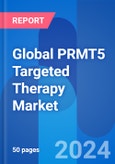Global PRMT5 Targeted Therapy Market & Clinical Trials Opportunity Outlook 2024 Report Highlights:
- PRMT5 Targeted Therapies Clinical Trials by Company, Indication & Phase
- PRMT5 Targeted Therapies in Clinical Trials: >25
- PRMT5 Targeted Therapies Research & Market Trends by Region: US, UK, EU, China & Canada
- Current Market Trends, Developments & Clinical Trials Assessment
- PRMT5 Targeted Therapy Approaches
- Application of PRMT5 Targeted Therapies by Indication
PRMT5, or Protein Arginine Methyltransferase 5, is an important enzyme with a variety of functions in cells. PRMT5 normally catalyzes the symmetrical and asymmetrical dimethylation of histone proteins, which plays an important role in post translational modifications. However, research studies conducted over the last two decades have revealed that its dysregulation promotes various disease processes, making it an attractive therapeutic target. Though the PRMT5 targeted therapies market is still in its early stages, with setbacks caused by the discontinuation of promising candidates, the current market landscape points to a future in which PRMT5 targeted therapies may become essential components of various treatment regimens for a wide range of diseases.
The initial research efforts for PRMT5 were focused on cancer, where it was discovered that PRMT5 methylates numerous of its substrates, which belong to diverse protein subclasses, resulting in varying pro-cancer effects. For example, PRMT5's methylation of the transcription regulator E2F1 shortens its half-life, which has oncogenic implications in colon cancer. Similarly, methylation of TDP1, a DNA damage response protein, increases its activity, hence preventing cancer cell death. PRMT5-mediated methylation of SRSF1, a splicing protein, has also been linked to carcinogenic activities in acute myeloid leukemia. As a result, inhibiting PRMT5 has a wide anticancer effect on both solid and hematological malignancies.
Beyond cancer, PRMT5 is linked in autoimmune and inflammatory diseases, where PRMT5 causes abnormal immune responses and inflammations via largely unknown pathways. PRMT5 promotes CD4+ T cell development via the NF-κB pathway, leading to elevated IL-2 production and proliferation. Furthermore, PRMT5 levels were elevated during the height of memory Th cell proliferation. Similarly, in microbial infections, particularly viral infections, PRMT5 has been linked to pathogen survival as well as antiviral and antibacterial responses. Again, this area is under-researched, but it has the potential to be treated with PRMT5 inhibitors, according to an increasing body of clinical investigations looking into the therapeutic benefits of PRMT5.
Multiple small-molecule PRMT5 inhibitors are now under research and clinical testing. The development of EPZ015666 by Epizyme and GSK in 2015 was a watershed moment in the field of PRMT5-targeted medicines. EPZ015666 was the first small chemical inhibitor of PRMT5 with over 20000-fold selectivity over 20 other protein methyltransferases. The two companies also developed EPZ015938, an analog of EPZ015666, but both programs were abandoned due to strategic considerations. Nonetheless, they laid the framework for establishing PRMT5 as a therapeutic target for anticancer therapies, as well as the potential of small molecule inhibitors to limit PRMT5 actions, both of which are still being widely investigated in research.
Next-generation inhibitors like AMG 193, AZD3470, TNG462 and SCR-6920 demonstrate improved specificity by optimizing interactions with particular sites on PRMT5. These have shown tumor growth inhibition in xenograft models. In addition, proteolysis targeting chimeras (PROTACs) technology and PRMT5 activators also offer alternative targeting approaches, considering PRMT5 has context-based functions in several diseases outside cancer.
Beyond monotherapies, combination strategies are also being explored in preclinical and clinical trials to enhance PRMT5 inhibition efficacy. Dual inhibition of PRMT5 and BCL-2 has shown potential for enhanced therapeutic effects, better than what was seen by the therapies alone. Such combinations aim to overcome compensatory survival signaling that can limit the therapeutic benefits of single agents. Amgen is also assessing the combination of its PRMT5 inhibitor AMG 193 in combination with the established chemotherapy drug, Docetaxel.
Regulatory bodies such as the FDA have also aided the development of PRMT5-targeted therapies by granting them designations, allowing their developers to obtain certain benefits. For example, in February 2023, the FDA designated JBI-778, a highly differentiated, substrate competitive PRMT5 inhibitor being developed by Jubilant Therapeutics, as an orphan drug for the treatment of Glioblastoma Multiforme. JBI-778 is being developed as an oral, brain-penetrant PRMT5 inhibitor for the treatment of both brain metastases and primary brain cancers. The Orphan Drug Designation grants tax breaks and market exclusivity upon approval, which can assist JBI-778 establish itself as a preferred therapy after marketing approval.
Commercially, targeting PRMT5 in order to inhibit or activate its functions represents a novel and viable strategy; however, this entirely depends on clinical benefits demonstrated in preclinical and clinical trials in specific indications. Given the potential broad applicability of PRMT5-targeting therapies, the first-in-class therapeutic to target PRMT5 may achieve high sales. Combination therapies could further expand market size. However, realizing the full clinical and commercial potential will require validating efficacy and defining suitable patient populations through biomarker-guided trials.
Table of Contents
Companies Mentioned (Partial List)
A selection of companies mentioned in this report includes, but is not limited to:
- Abbisko Therapeutics
- Agios Pharmaceuticals
- Amgen
- AstraZeneca
- Aurigene Oncology
- CytosinLab Therapeutics
- Epizyme (Ipsen)
- IngenOx Therapeutics
- Johnson & Johnson
- Jubilant Therapeutics
- Mirati Therapeutics
- Ryvu Therapeutics
- Schrodinger
- Simcere Pharmaceutical Group
- SK Life Science
- Tango Therapeutics








